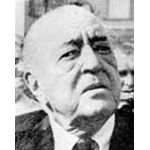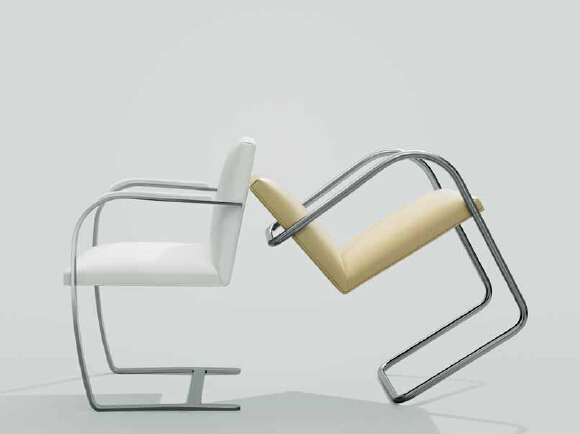Brno Chair
InJoy
Detail:
Mies Van Der Rohe
Barcelna Ottoman -FA288D

Ludwig Mies van der Rohe (1886 – 1969) was a German-American architect. He is commonly referred to and was addressed as Mies, his surname. Along with Le Corbusier, Alvar Aalto, and Arne Jacobsen, he is widely regarded as one of the pioneering masters of modern furniture.
Mies, like many of his post-World War I contemporaries, sought to establish a new architectural style that could represent modern times just as Classical and Gothic did for their own eras. He created an influential twentieth-century architectural style, stated with extreme clarity and simplicity. His mature buildings made use of modern materials such as industrial steel and plate glass to define interior spaces. He strove toward an architecture with a minimal framework of structural order balanced against the implied freedom of free-flowing open space. He called his buildings "skin and bones" architecture. He sought a rational approach that would guide the creative process of architectural design, but he was always concerned with expressing the spirit of the modern era. He is often associated with his quotation of the aphorisms, "less is more" and "God is in the details".
Mies designed modern furniture pieces using new industrial technologies that have become popular classics, such as the Barcelona chair and table, the Brno chair, and the Tugendhat chair. His furniture is known for fine craftsmanship, a mix of traditional luxurious fabrics like leather combined with modern chrome frames, and a distinct separation of the supporting structure and the supported surfaces, often employing cantilevers to enhance the feeling of lightness created by delicate structural frames. During this period, he collaborated closely with interior designer and companion Lilly Reich.
The modern city, with its towers of glass and steel, can be at least in part attributed to the influence of architect Ludwig Mies van der Rohe. Equally significant, if smaller in scale, is Mies' daring design of furniture, pieces that exhibit an unerring sense of proportion, as well as minimalist forms and exquisitely refined details. In fact, his chairs have been called architecture in miniature – exercises in structure and materials that achieve an extraordinary visual harmony as autonomous pieces and in relation to the interiors for which they were designed.
Mies van der Rohe began his career in architecture in Berlin, working as an architect first in the studio of Bruno Paul and then, like Le Corbusier and Walter Gropius, for Peter Behrens. In 1927, a housing project called Weissenhof Siedlung in Stuttgart, Germany, would bring these names together again. Widely believed to be one of the most notable projects in the history of modern architecture, it includes buildings by Gropius, Corbu, Behrens, Mies and others.
In 1928, Mies and his companion and colleague, the designer and Bauhaus alumna Lilly Reich, were asked to design the German Pavilion for the 1929 International Exposition in Barcelona. The purpose of the Pavilion was to provide a location that could be visited by the king and queen of Spain during the opening of the Exposition. With that in mind, Mies designed a modern throne – known today as the Barcelona Chair – for their majesties. In the following year, Mies designed another notable chair, the Brno, with a gravity-defying cantilevered base.
In 1930, Mies succeeded Walter Gropius as the director of the Bauhaus, where he stayed until the school closed in 1933. In 1937, Mies emigrated from Europe to the United States, and a year later became the director of architecture at the Illinois Institute of Technology. The rest of his career was devoted to promoting the modernist style of architecture in the U.S., resulting in rigorously modern buildings such as the Farnsworth House and the Seagram Building, designed with Philip Johnson.
Product Description:
Brno Chair (1930) is Mies Van Der Rohe masterpiece, paying tribute to early modernism's gravity-defying skyscrapers. The Brno Flat Chair mirrors the ground breaking simplicity of its original environment. A simple profile, clean lines and meticulous attention to detail have elevated the Brno Flat Chair to an icon of twentieth century furniture design. The Brno Flat chair has become a modern furniture classic.
Brno Flat chair is a more luxurious variant of the dining chair.
Brno Flat chair progressive design features a single steel tube that acts as the armrest, frame and chair legs. The comfortable seat and chair back are available in high quality leather or fabric.
The Chair is available in two versions: the Brno Tubular Chair and the Brno Flat Chair.













